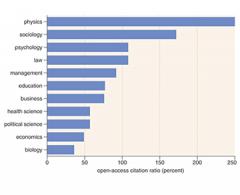
This Article From Issue
May-June 2007
Volume 95, Number 3
Page 195
DOI: 10.1511/2007.65.195
To the Editors:
Ronald F. Fox and Theodore P. Hill make an interesting case for defining Avogadro’s number (Macroscope, March–April) as the cube of an integer, and present a list of ten integers whose cube falls within the uncertainty of the present best estimate of this fundamental constant. They prefer the value 84,446,888 since, of the ten, its cube lies closest to the best estimate. Of the ten acceptable numbers, 84,446,891 is a prime number and its cube is only 5.53–7 larger than the best estimate. The other nine suggested numbers are all messy composites. If we are going to define a number on the basis of the value of its cube, I support the prime number.
Frank J. Donahoe
Wilkes University
Wilkes-Barre, PA
To the Editors:
I am also a strong proponent that Avogadro’s number should be a constant and all the physical measurements be changed where necessary; especially the mass of that chunk of metal. While the treatise is interesting, 84,446,8883 is not particularly “elegant and easy.” In 1999 I proposed the binary mole (No = 279) which is 6.024 × 1023 (See arxiv.org/html/physics/9904016). If one is looking for simplicity, elegance and an easy-to-remember constant value for Avogadro’s number, this is it.
Joel M. Williams
Los Alamos, NM
To the Editors:
I enjoyed “An Exact Value for Avogadro’s Number,” and found other ways of associating the authors’ NA* with a crystal structure. The authors’ face-centered cube depicts 18 atoms, but only eight are part of a repeating unit cube forming a crystal lattice. The other 10 belong to adjacent unit cubes. So we could think of a cube holding Avogadro’s number of atoms as made up of 10,555,736 unit cubes on an edge with each unit having eight atoms. This would indicate that Avogadro’s number is perfect cube divisible by 83.
Another view can be obtained by rotating the face-centered cube 45 degrees clockwise to reveal a plane of tetrahedrons, each with four atoms bonded to a central one. We could twist the cube in space and locate three more views, each containing the same exact array of tetrahedrons. A basic unit of this lattice is a small rhomboid with nine atoms—one at each corner and one internal to the rhomboid. A tetrahedron is formed by four adjacent corner atoms bonded to the internal one. Two atoms of this rhomboid, the internal one and a corner one bonded to it, form a repeating unit of the crystal lattice. The other seven atoms belong to adjacent units.
So we could also think of a rhomboid containing Avogadro’s number of atoms as having 42,223,444 unit rhomboids on an edge with each unit having two atoms, one corner atom and the central tetrahedral atom bonded to it. This would indicate that Avogadro’s number is divisible by 23.
Finding that NA* is divisible by 23 and 83 is a rather interesting result, but there are others. The first eight cubic divisors of NA* are 13, 23, 43, 83, 173, 343, 683, and 1363. The cube 13 is associated with a perfect cube. The cubes 23 and 83 are associated with a rhomboid and face-centered cube, respectively. That leaves at least five other perfect cubes. Are there more? Can spatial configurations be attached to the other nine perfect cubes that the authors have set aside?
Ronald Csuha
New York, NY
Drs. Fox and Hill respond:
We are gratified that our article has generated general interest.
Dr. Donahoe’s suggestion was included in our list of acceptable perfect cubes, and known by us to be prime, but we had a slight preference for the cube closest to the center of the known range of values. As we stated, any of the ten cubes in that range will serve equally well. Dr. Williams’ suggestion that 279 is a simpler choice is true enough, but 6.024 × 1023 is well outside the current accepted range of values of 6.0221415(10) × 1023.
Dr. Csuha made interesting remarks about crystal structure. However, each of Dr. Csuha’s divisors follows from the prime factors of 84,446,888 = 2 × 2 × 2 × 17 × 620,933 that are connected to the crystal lattice. But we prefer a number that is not linked to any particular lattice structure, simply because the defining base element (currently carbon-12) has been changed before, and may well be changed again, in which case the corresponding lattice structure may change. Also, the suggestion of a number based on crystal structures presupposes that one day it may be possible to assemble NA* atoms of a pure isotope into the required arrangement. Imagine a process that self-assembles the atoms at a rate of a billion per second. It would take 10 million years to finish. Thus, choosing a particular integer for NA* is sufficient to remove the artifact, Le Gran K, from further usage as a mass standard and consequently redefines the kilogram.

American Scientist Comments and Discussion
To discuss our articles or comment on them, please share them and tag American Scientist on social media platforms. Here are links to our profiles on Twitter, Facebook, and LinkedIn.
If we re-share your post, we will moderate comments/discussion following our comments policy.